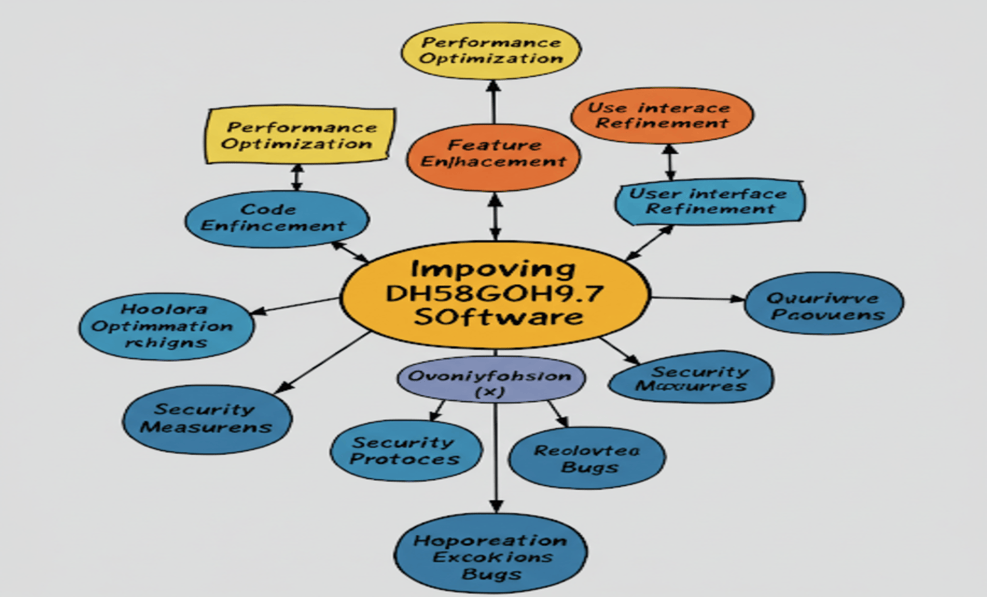How to Improve DH58GOH9.7 Software: A Step-by-Step Plan
Software is a living entity—constantly evolving to meet user demands and technological advancements. For DH58GOH9.7 software, a tool celebrated for its [specific functionality, e.g., data management, automation, or analytics], the path to sustained relevance lies in strategic improvements. This article dives deep into actionable steps to improve DH58GOH9.7 software in future updates, ensuring it remains powerful, user-friendly, and adaptable.
Understanding the Current Challenges
Before outlining solutions, let’s dissect the existing limitations of DH58GOH9.7 software. User reviews, developer audits, and performance benchmarks highlight recurring issues:
- Performance Bottlenecks: Slow response times during high-load tasks, especially with large datasets.
- Outdated Design: A cluttered interface that complicates navigation for new users.
- Security Gaps: Vulnerabilities in data encryption and user authentication.
- Compatibility Issues: Struggles with newer operating systems and third-party integrations.
- Limited Scalability: Difficulty adapting to growing user bases or complex workflows.
These challenges create friction for users and hinder the software’s potential. Addressing them systematically will improve DH58GOH9.7 software’s functionality and market appeal.
Optimizing Performance: Speed and Efficiency
Performance is the cornerstone of user satisfaction. To improve DH58GOH9.7 software in future versions, developers must prioritize:
Codebase Refactoring
- Legacy Code Modernization: Replace outdated code segments with efficient, modular scripts. For example, transitioning from linear processing to asynchronous operations can reduce latency.
- Algorithm Optimization: Upgrade data sorting or rendering algorithms. Implementing quicksort over bubblesort for large datasets, for instance, can cut processing time by 50-70%.
- Memory Leak Fixes: Use tools like Valgrind or AddressSanitizer to identify and patch memory leaks, ensuring smoother multitasking.
Hardware Utilization
- GPU Acceleration: Offload rendering or computation tasks to the GPU. Libraries like CUDA or OpenCL can enhance performance in graphic-heavy operations.
- Multithreading: Implement parallel processing for tasks like batch exports or real-time analytics. This reduces wait times and improves responsiveness.
Caching Mechanisms
- Introduce smart caching for frequently accessed data (e.g., user preferences, templates). This minimizes database calls and speeds up load times.
Modernizing UI/UX: Bridging the Gap Between Power and Simplicity
A polished interface attracts users, but a functional one retains them. To improve DH58GOH9.7 software’s design:
User-Centric Design Principles
- Simplified Navigation: Adopt a tab-based layout or collapsible menus to reduce clutter. Tools like Figma or Adobe XD can help prototype intuitive workflows.
- Dark Mode & Accessibility: Add dark mode to reduce eye strain and ensure compliance with WCAG 2.1 standards (e.g., text contrast ratios, keyboard navigation).
- Customizable Workspaces: Let users save and share personalized layouts. For example, data analysts might prioritize dashboards, while developers prefer code panels.
Onboarding and Support
- Interactive Tutorials: Embed guided walkthroughs for first-time users to explain core features.
- Contextual Tooltips: Provide hover-over explanations for complex buttons or settings.
Fortifying Security: Building Trust Through Robust Protocols
Cybersecurity is non-negotiable. To improve DH58GOH9.7 software in future updates:
Data Protection
- End-to-End Encryption (E2EE): Use AES-256 or RSA-4096 encryption for data at rest and in transit.
- Zero-Trust Architecture: Require identity verification for every access request, even within internal networks.
User Authentication
- Multi-Factor Authentication (MFA): Support options like SMS, authenticator apps, or biometric scans.
- Session Timeouts: Automatically log users out after periods of inactivity to prevent unauthorized access.
Compliance and Audits
- GDPR/CCPA Compliance: Ensure data handling meets regional regulations.
- Penetration Testing: Hire ethical hackers to simulate breaches and identify vulnerabilities.
Enhancing Compatibility and Integration
Modern workflows demand interoperability. To improve DH58GOH9.7 software’s versatility:
Cross-Platform Support
- Native OS Compatibility: Test and optimize the software for Windows 11, macOS Ventura, and Linux distributions like Ubuntu 22.04 LTS.
- Browser-Based Access: Develop a lightweight web version using frameworks like React or Angular for users who prefer cloud access.
Third-Party Integrations
- API Development: Build RESTful APIs to connect with tools like Microsoft Teams, Salesforce, or Tableau. For example, an API endpoint could auto-export reports to Slack channels.
- Plugin Ecosystem: Allow developers to create custom plugins, fostering a community-driven extension library.
Cloud and Hybrid Solutions
- AWS/Azure Integration: Enable seamless data sync with cloud storage (e.g., S3 buckets, Azure Blob).
- Hybrid Deployment: Support both on-premise and cloud setups for enterprises with strict data governance needs.
Leveraging AI and Machine Learning
AI can transform DH58GOH9.7 software from a tool to a strategic partner. Key implementations include:
Predictive Analytics
- Use ML models (e.g., TensorFlow, PyTorch) to forecast trends from historical data. For instance, predict server load peaks to allocate resources proactively.
Automation
- Smart Scripting: Let users automate repetitive tasks via natural language commands (e.g., “Generate monthly report every 25th”).
- Anomaly Detection: Train models to flag unusual activity, like sudden data spikes or unauthorized access attempts.
Natural Language Processing (NLP)
- Integrate chatbots (e.g., Dialogflow, Rasa) for instant user support, reducing reliance on human agents.
Community-Driven Development: Listening to the Users
Users know the software’s pain points best. To improve DH58GOH9.7 software in future iterations:
Feedback Loops
- Dedicated Portals: Create a public roadmap where users vote on features (e.g., Canny.io).
- Surveys and Analytics: Use tools like Hotjar to track user behavior and identify friction points.
Beta Programs
- Early Access Releases: Offer beta versions to power users in exchange for detailed feedback.
- Bug Bounties: Incentivize users to report vulnerabilities with rewards or recognition.
Future-Proofing: Preparing for Tomorrow’s Tech
To ensure DH58GOH9.7 software remains relevant, developers must:
Adopt Modular Architecture
- Design the software as microservices (e.g., Docker containers) for easy scaling and updates.
Embrace Emerging Technologies
- Quantum Computing Readiness: Optimize algorithms for quantum-speed processing.
- Edge Computing Support: Enable data processing on local devices (e.g., IoT sensors) to reduce latency.
Sustainable Practices
- Energy-Efficient Coding: Reduce CPU/GPU usage to lower the software’s carbon footprint.
Conclusion
The mission to improve DH58GOH9.7 software is a blend of technical upgrades and user-centric innovation. By prioritizing performance, security, and adaptability, developers can transform the software into a future-ready powerhouse. For users, engaging with feedback channels ensures their needs shape the roadmap. Together, these steps will solidify DH58GOH9.7 software’s position as a leader in its domain.
Read More : is xovfullmins dangerous , tizavuhovhulo
Frequently Asked Questions (FAQs)
1. How will AI integration specifically improve DH58GOH9.7 software?
AI will automate repetitive tasks, enhance data analysis accuracy, and provide predictive insights. For example, ML models could forecast system errors before they occur, enabling proactive maintenance.
2. What steps ensure the software remains compatible with future OS updates?
Adopting cross-platform frameworks like Electron or Qt and maintaining regular communication with OS developers for early access to beta systems ensures seamless compatibility.
3. Can small businesses benefit from these improvements?
Absolutely! Features like cloud integration, customizable workflows, and AI-driven automation will help small teams operate more efficiently without requiring extensive IT resources.
Read Also :







